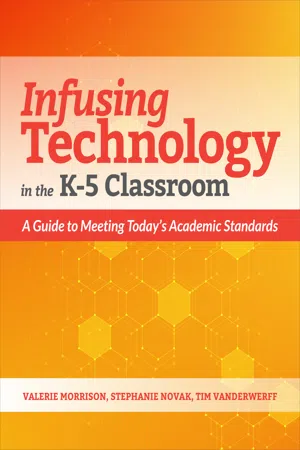
Infusing Technology in the K-5 Classroom
A Guide to Meeting Today's Academic Standards
Valerie Morrison, Stephanie Novak, Tim Vanderwerff
- English
- ePUB (disponibile sull'app)
- Disponibile su iOS e Android
Infusing Technology in the K-5 Classroom
A Guide to Meeting Today's Academic Standards
Valerie Morrison, Stephanie Novak, Tim Vanderwerff
Informazioni sul libro
K-5 teachers will discover how to integrate the tech requirements found within today's academic standards into their everyday curriculum. Perhaps your district provides current technology development for staff on a regular basis and has instructional coaches to help teachers infuse technology into their curriculum to meet various academic standards. But in reality, most districts don't have this kind of support. In this book (the first in a two-book series), you'll learn how to shift your instructional practice and leverage technology to meet today's curriculum education standards for grades K-5. This book doesn't cover every K-5 national standard, but identifies the standards with a technology component and provides resources and lessons to help you teach those standards effectively.This book includes:
- Classroom-tested lesson ideas in English language arts, math, science and social studies mapped to ISTE and tech-related standards to support college- and career-readiness.
- Lists of technology-embedded college- and career-readiness standards for each grade level, along with practical ideas and up-to-date resources (apps, software and websites) that can be used in meeting these standards.
- Suggestions for addressing roadblocks to incorporating technology in the classroom.
- Ways to incorporate staff development and parental support at the school level.
- Access to a companion website with information on the tools referenced in the text.
With the implementation of these strategies, you'll help your students become self-directed and critical readers, writers and thinkers so they're better prepared for the future! Audience: K-5 educators, curriculum specialists, tech coordinators
Domande frequenti
Informazioni
Chapter 1
Today’s Students
Who Are Your Students?
What Does This Generation Know and Do?
How Has Technology Affected Students’ Minds?
How Has Technology Affected Behavior?
How Do We Move Beyond the ABCs?
How Can Educators Succeed in the Digital Age?
Chapter 2
Parent Education
Why Do Parents Need to Know about Technology Standards?
Indice dei contenuti
- Cover
- Title Page
- Copyright
- About ISTE
- About the Authors
- Acknowledgments
- Dedication
- Table of Contents
- Introduction
- Chapter 1: Today’s Students
- Chapter 2: Parent Education
- Chapter 3: Roadblocks to Technology
- Chapter 4: Staff Development
- Chapter 5: Organization of the Standards
- Chapter 6: Technology in the Common Core
- Chapter 7: Implementing Practical Ideas
- Chapter 8: Practical Ideas for Kindergarten
- Chapter 9: Practical Ideas for First Grade
- Chapter 10: Practical Ideas for Second Grade
- Chapter 11: Practical Ideas for Third Grade
- Chapter 12: Practical Ideas for Fourth Grade
- Chapter 13: Practical Ideas for Fifth Grade
- References